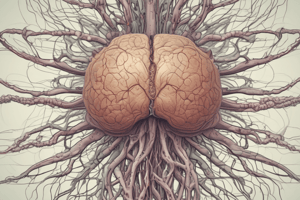Podcast
Questions and Answers
What is the primary function of the Central Nervous System (CNS)?
What is the primary function of the Central Nervous System (CNS)?
- To interpret and integrate sensory information (correct)
- To regulate body functions, such as movement and sensation
- To transmit information to and from the Peripheral Nervous System
- To produce and regulate hormones
What is the role of dendrites in neurons?
What is the role of dendrites in neurons?
- To receive signals from other neurons (correct)
- To release neurotransmitters
- To transmit signals to other neurons
- To contain the nucleus and organelles
Which gland is often referred to as the 'master gland' due to its role in regulating other endocrine glands?
Which gland is often referred to as the 'master gland' due to its role in regulating other endocrine glands?
- Pancreas
- Adrenal Gland
- Thyroid Gland
- Pituitary Gland (correct)
How do hormones affect the nervous system?
How do hormones affect the nervous system?
What is the primary function of the Peripheral Nervous System (PNS)?
What is the primary function of the Peripheral Nervous System (PNS)?
What is the primary function of the nervous system?
What is the primary function of the nervous system?
What is the role of the adrenal glands in the endocrine system?
What is the role of the adrenal glands in the endocrine system?
How do the nervous and endocrine systems interact?
How do the nervous and endocrine systems interact?
Flashcards are hidden until you start studying
Study Notes
Nervous System
Functions:
- Controls and coordinates body functions
- Interprets and responds to sensory information
- Facilitates communication between different parts of the body
- Regulates body functions, such as movement, sensation, and emotions
Components:
- Central Nervous System (CNS): brain and spinal cord
- Interprets and integrates information
- Controls voluntary actions
- Peripheral Nervous System (PNS): nerves outside the CNS
- Transmits information to and from the CNS
- Divided into sensory (receives information) and motor (transmits information) nerves
- Neurons: specialized cells that transmit and process information
- Dendrites: receive signals
- Cell Body: contains nucleus and organelles
- Axon: transmits signals
- Terminal Buttons: release neurotransmitters
Endocrine System
Functions:
- Produces and regulates hormones that control various body functions
- Maintains homeostasis and regulates growth and development
- Interacts with the nervous system to control body functions
Components:
- Endocrine Glands: produce and secrete hormones directly into bloodstream
- Pituitary Gland: master gland that regulates other endocrine glands
- Thyroid Gland: regulates metabolism
- Adrenal Glands: regulates stress response and electrolyte balance
- Pancreas: regulates blood sugar levels
- Ovaries and Testes: produce sex hormones
- Hormones: chemical messengers that regulate body functions
- Steroid Hormones: derived from cholesterol
- Peptide Hormones: derived from amino acids
Interaction between Nervous and Endocrine Systems
- The nervous system regulates the release of hormones from endocrine glands
- Hormones can affect the nervous system by binding to receptors on neurons
- Both systems work together to maintain homeostasis and regulate body functions
Nervous System
Functions
- Coordinates and controls body functions, such as movement, sensation, and emotions
- Interprets and responds to sensory information from the environment
- Facilitates communication between different parts of the body
Components
Central Nervous System (CNS)
- Consists of the brain and spinal cord
- Interprets and integrates information
- Controls voluntary actions
Peripheral Nervous System (PNS)
- Comprises nerves outside the CNS
- Transmits information to and from the CNS
- Divided into sensory nerves (receive information) and motor nerves (transmit information)
Neurons
- Specialized cells that transmit and process information
- Have three main parts: dendrites, cell body, axon, and terminal buttons
- Dendrites receive signals
- Cell body contains nucleus and organelles
- Axon transmits signals
- Terminal buttons release neurotransmitters
Endocrine System
Functions
- Produces and regulates hormones that control various body functions
- Maintains homeostasis and regulates growth and development
- Interacts with the nervous system to control body functions
Components
Endocrine Glands
- Produce and secrete hormones directly into the bloodstream
- Include pituitary gland, thyroid gland, adrenal glands, pancreas, ovaries, and testes
- Pituitary gland is the master gland that regulates other endocrine glands
Hormones
- Chemical messengers that regulate body functions
- Can be steroid hormones (derived from cholesterol) or peptide hormones (derived from amino acids)
Interaction between Nervous and Endocrine Systems
- Nervous system regulates the release of hormones from endocrine glands
- Hormones can affect the nervous system by binding to receptors on neurons
- Both systems work together to maintain homeostasis and regulate body functions
Studying That Suits You
Use AI to generate personalized quizzes and flashcards to suit your learning preferences.




